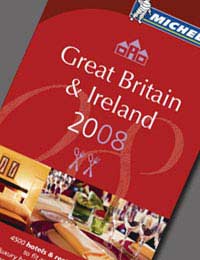The History of the Michelin Guide

The Michelin Guide has been a key indicator of good food for over 100 years.
It is clear how important the guide is to the hospitality industry when the annual results of those establishments being awarded one, two or three stars is featured on the main television news programme.
How the Michelin Guide Started
The Michelin Guide was started in 1900 by Andre Michelin, a member of the innovative car products company that produce Michelin tyres. Based in France, the guides were first produced to help drivers locate garages and fuel suppliers during their journeys across France. It included good places to find food and lodging for overnight stays which, as it was written for Frenchmen, had a great focus on the quality and affordability of the meals.Initially the guide just mentioned a little bit about what food was cooked, how well it was cooked and the price, with the now-famous stars introduced in 1926. At first there was only one star to show a particularly good establishment, although the two and three star rating was introduced in 1926 to differentiate between exceptional and the merely excellent or good.
Travelling Outside France
As driving became more common, the guides extended to other major European cities, including London. Having grown from a French idea, with the French Michelin Guide still the most comprehensive, there has been some criticism that the guide is somewhat snobbish and too biased towards French cooking. While there is perhaps some truth in that, the red book remains a much respected guide to good food. There are a number of more modern food guides, such as Zagats, which had gained a real following for its more internationally-focused guide to cuisines in major cities, the coveted Michelin star is a driving force for many chefs.Explaining the Star System
The three star system continues today, with each star representing a great achievement in cooking. As its roots still lie in driving to find good food, the categories are defined as – one star denotes ‘a good restaurant or pub in its category – a good place to stop’; two stars are for ‘excellent cooking – worth a detour; with the very rare three stars given for ‘exceptional cuisine – worth a special journey’.The stars are also indicative of the price one may expect to pay. With many three star establishments offering tasting menus for in excess of £120 per head, without wine (which can easily add a further £100 if you go for the sommeliers tasting menu choice) it is certainly not offering ‘truck stop’ prices!


Re: Why Do You Want to Open a Restaurant?
If you had NOTHING to do what would me you coming with an Idea of opening a restauront
Re: Why Do You Want to Open a Restaurant?
Hello. I would like to open tea rooms in Coventry. What are my first steps? where to start??
Re: Get Funding for Your Restaurant
Hi, I would like some information about funding of a restaurant that sells Smoke BBQ Food.
Re: Why Do You Want to Open a Restaurant?
Hi, looking for pizza to open. New here, need some advices how it is organized here. Any tips advice or consultaion…
Re: The Rules for Staff Tips and Gratuities
I know this is an old thread but there's not much guidance for this in the uk. In the US it is illegal for bosses to…
Re: Get your New Restaurant Noticed
Totally agree about spending money where money is needed to be spent, there is nothing worse than cutting corners. You can…
Re: Is There a Right Time to Open a Restaurant?
@Paul - I have included the North Somerset Council funding and grants link here. I hope this helps.
Re: Is There a Right Time to Open a Restaurant?
Hi there I'm looking to start a restaurant I'm a chef of 18 years Ive been working on a business plan for…
Re: Get Funding for Your Restaurant
Hi I would like to get information about the funding of a restaurant that sells African meals.
Re: Designing Your Restaurant
I am at college studying catering and hospitality and im want to open my own resturant, but I dont know what to start with?